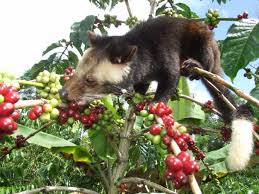
Luwak eating coffee berries
Part of the fun of traveling is to experience new foods and beverages. Part of the mystery of Asia is to discover exactly what it is you’re consuming, as the name may be misleading.
Kopi Luwak
Take kopi luwak, for instance. A luwak is a civet, a member of the weasel family found in Indonesia. Normally weasels’ major contribution to humanity is small rodent control or fur (think minks) but in Indonesia, luwaks are prized for their feces. Yup, those little nuggets of luwak feces are as valuable as gold. Kopi luwaki is a highly praised and tasty coffee made from the fecal pellets of coffee. I know because I’ve drunk it.
The nocturnal luwak dines on ripe coffee berries. Somehow the civets’ digestive process gives the berries a robust, tasteful flavor — once the berries have been separated from the fecal matter and roasted, that is.
How did weasel shit become a worldwide phenomenon? Short History Lesson (SHL) #1:The Dutch controlled much of present day Indonesia for centuries. Among the spices and foods that made the Dutch East India Company the richest conglomerate in the world was the discovery of coffee. Soon coffee plantations sprouted all over Indonesia, and the natives, who formerly enjoyed cups of this tasty beverage while relaxing in the sun were transformed into near-slaves working the plantations while their Dutch masters enjoyed their coffee in the sun. In order to maximize profits, the Dutch forbid the Indonesians to consume any coffee.
At some point the workers noticed that luwak poop contained partly digested coffee berries which they collected, cleaned, roasted and brewed into a delicious tasting coffee. Kopi luwak or weasel coffee was born. Now it is an industry in Indonesia, Vietnam and other areas of Southeast Asia.
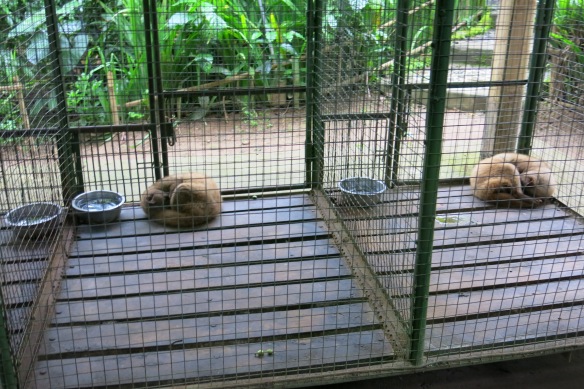
Nocturnal animals, luwaks snooze most of the day.
Kopi luwak is not without its production issues, however, not the least of which is animal abuse. In order to maximize their profits, Indonesians began to capture and keep luwaks in cages in order not to have to waste time searching for those small weasel pellets in the jungle. Often these cages are highly restrictive and the luwaks are forced to eat nothing but coffee berries, sparking a rash of protests from animal rights activists. From the natives’ point of view, caging luwaks is expedient.
Besides, there are poisonous snakes and other venomous creatures out there in the jungle, just waiting to nab some poor guy scooping up weasel poop from the jungle floor.
For the average Indonesian, luwak poop is a highly profitable commodity: one cup of this brew can sell between $30 to $100 in the U.S. Roasted and bagged for sale in the Western markets, the beans can sell for as much as $650 a kg (about $340+ per pound).
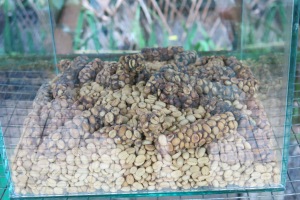
A pile of luwak feces with partially digested coffee beans. The beans are separated from the fecal matter, cleaned and roasted and are ready for brewing into “cat-poo-chino.”
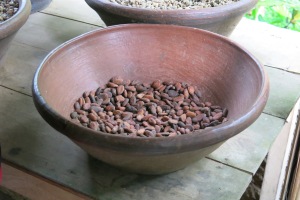
Roasted coffee beans
Thankfully, the voices of activists have been heeded and many luwak coffee “growers” are providing more humane treatment of their captive luwaks or just plain harvesting the coffee dung the old-fashioned way.
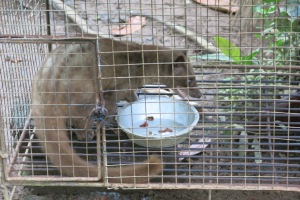
One of the plantation’s luwaks awake near dusk and rarin’ to go…
Putting aside my scruples, however, I drank a cup of luwak coffee in Bali after forking over $5 USD, what is in Indonesia an outrageous sum. Yes, it was tasty, but so is a cup of well-brewed French or Italian roast coffee. The coffee plantation workers who were leading our tour and hawking the various coffees to us were somewhat amazed that any of these weird white folk were actually drinking weasel fecal-processed stuff, but hey: they were the ones pushing “Cat-poo-chino” as proclaimed on their T-shirts and menus.
Personally, I thought “Crap-pu-cino” had a snazzier ring to it but hey, I’m the consumer, not the marketer.
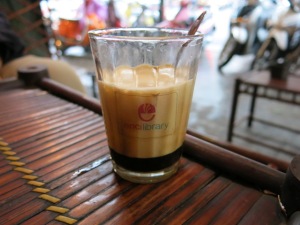
Egg coffee at Coffee Long in Hanoi
Egg Coffee
A more innocuous, coffee-based drink is the egg coffee consumed in northern Vietnam. While in Hanoi, we drank this delicious concoction. I’d expected coffee with curdled egg mixed in it, kind of like a a coffee-based egg-drop soup. Thankfully, the egg coffee was far more pleasant – very rich and sweet.
As recipes go, it couldn’t be more simple: brew some good, strong coffee, let it cool slightly, add sweetened, condensed milk and one egg yolk, and stir: egg coffee. Loved it.
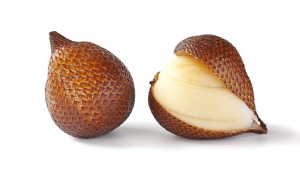
Snakeskin fruit or salak in Bali
Snakeskin Fruit, Durian, Dragon fruit and Vietnamese Glutinous Wine
In the past five weeks of our Southeast Adventure, Michael and/or I have tried various other local delicacies. I ate some snakeskin fruit (salak in Indonesian) in Bali. The name is derived from its formidable looking skin which does resemble that of a brown snake. The cream colored wedges inside taste both sour and sweet at the same time with a nice crunch, not dissimilar to a slightly unripe pear.
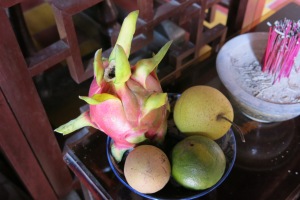
Dragon fruit is upper left fruit in this Buddhist altar offering, Hoi An, Vietnam
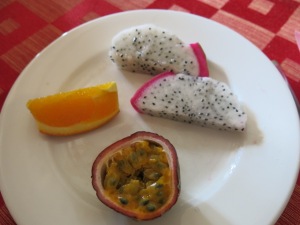
Clockwise from top left: orange, dragon fruit and passion fruit
Dragon fruit looks quite formidable, earning its name. Inside, dragon fruit is white with tiny black seeds and a sweet, soft crunch. I eat it for breakfast almost every morning, along with passion fruit, if available. Passion fruit is a bit more of a visual-taste challenge. The seeds are encased in a glutinous jelly that reminds me of frog eggs. Once I got past the image, I could eat the pulpy mess which also tastes both sweet and very slightly sour.

Fresh durian with processed durian chips.
Durian is a challenge I’ve never mastered. People either love it or hate it. The majority of westerners fall into the latter category, but it’s worthy of note that Singapore bans open durian from any form of public transportation. When opened, durian stinks to high heaven. Processed into candied fruit bites or chips, however, it’s palatable.
Glutinous Wine
Vietnamese “glutinous wine” causes pause when first encountered on a drinks menu. However, it’s just rice wine; whether it has a milky or glutinous quality depends on how well it has been distilled. Home-brewed rice wine will be both milky and quite glutinous with characteristics I really didn’t like to contemplate and that I’m sure were never in the glossary in a sommelier’s curriculum.
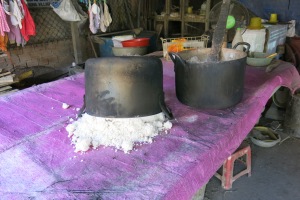
Cooked rice dumped out on a tarp before distilling in a Hoi An shophouse.
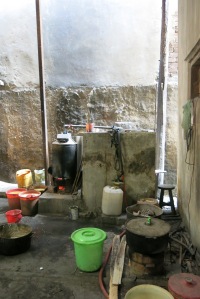
Home still for brewing “glutinous” (rice) wine in Hoi An, Vietnam
We actually sampled the rice wine from this still, then allowed ourselves to be “persuaded” to buy a bottle. I was a bit perturbed when the shopkeeper fished a filthy plastic bottle out of a bucket of other used bottles, then filled it for us from the still, but we paid the one dollar and took it. I fed the fishes with it later.
And I thought that home-brewed plain old glutinous rice wine was revolting…
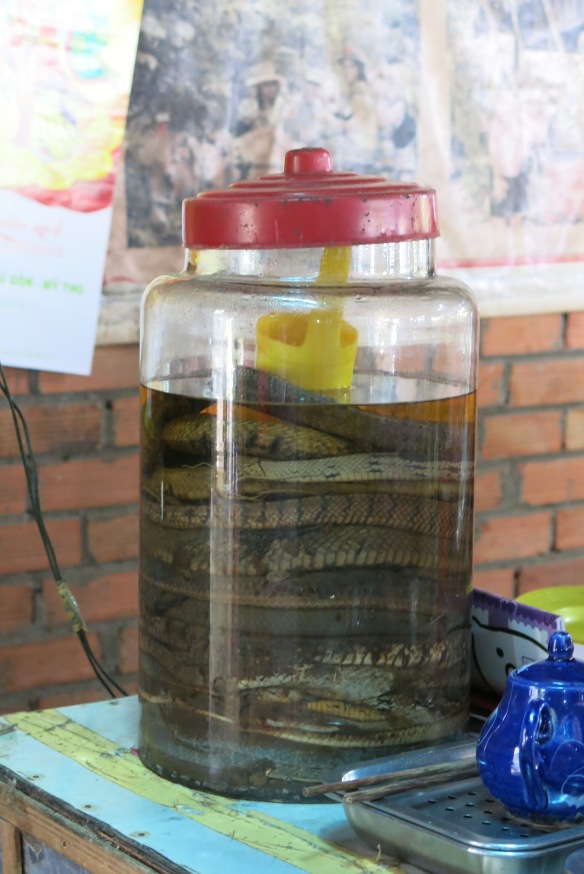
Snake wine: cobra and other snakes fermenting in rice wine. Blood from the snakes give this wine its reddish-brown color.
Snake Wine
The one local product I absolutely refused to sample was snake wine. The preferred snake in this type of rice wine is cobra, but smaller snakes usually are added to the brew.
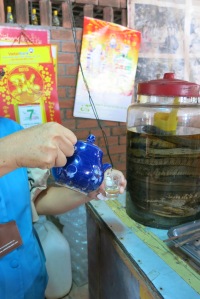
Our guide poured snake wine fro this teapot after filling it from the jar of snake wine behind her.
Michael, however, was game. Quite honestly, I could barely take the pictures, but to the guide’s amazement, he downed the entire cup she poured for him.
As it turns out, Michael didn’t just drink snakes-fermented-in-rice-wine. He had “snake blood wine,” where the snakes’ bellies are slit to allow blood to seep into the mixture, giving the liquid that reddish tinge.
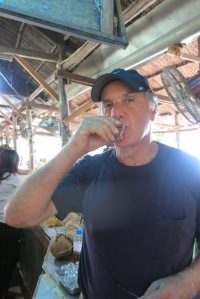
Michael drinking snake blood wine.
And, no, Michael didn’t go puke in the bushes afterwards. He wanted to buy some. I threatened divorce. (I think he sneaked some into his back pack so look out, friends.)
As we head off to Laos, Cambodia, Myanmar and Korea, I can only imagine what additional gustatory challenges await. But I know one thing: if it’s reptile, I ain’t touching it. Michael, go for it, babe!
![]()

Carol Barbier Rolnick grew up in Japan and Southeast Asia, traveling extensively as a child through Asia, the Mideast and Europe on family vacations. Travel has continued as a priority through raising kids and continuing into retirement, extending adventures through the Americas, southern Africa, Asia, and repeat trips throughout Europe. Carol and her husband, Michael spent four summers based in Utrecht, The Netherlands, which has become like a second home. They are (still) aiming towards Australia-New Zealand and Antarctica to round off their continental travels.








